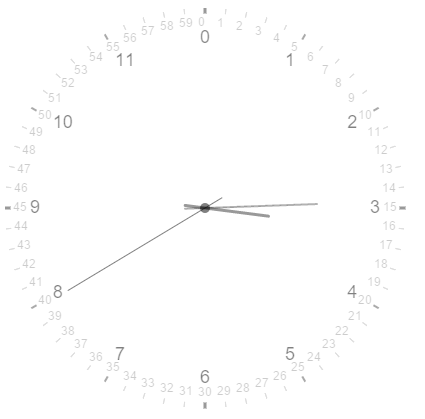用HTML5的canvas做一个时钟
对于H5来说,canvas可以说是它最有特色的一个地方了,有了它之后我们可以随意的在网页上画各种各样的图形,做一些小游戏啊什么的。canvas这个标签的用法,在网上也有特别多的教程了,这里就不作介绍了。今天我们就用canvas来做一个小小的时钟。完整的代码在这里https://github.com/wwervin72/jQuery。
那么首先在这个页面里面我使用了两个canvas,一个用来绘制静态的时钟表盘和刻度,另一个用来绘制时钟的三个指针,然后用定位让他们重合到一起。然后这里没什么好说的,下面附上代码。
<canvas id="plate"> 画表盘 </canvas> <canvas id="needles"> 画时针 </canvas>
var plate=document.getElementById('plate'); var needles=document.getElementById('needles'); needles.setAttribute('style','position:absolute;top:8px;left:8px;'); //这里因为chrome里面,body的magin值为8px,所以我这里就没设为0了。 var cntP=plate.getContext('2d'); var cntH=needles.getContext('2d'); plate.width=800; plate.height=500; needles.width=800; needles.height=500;
到了这里准备工作就做完了,下面就准备绘制时钟了。我先定义了一个绘制时钟表盘的构造函数。
function drawclock(cnt,radius,platelen,linewidth,numLen,NUMLEN){ this.cnt=cnt; this.radius=radius; this.platelen=platelen; this.linewidth=linewidth; this.numLen=numLen; this.NUMLEN=NUMLEN; this.getCalibCoor=function(i){ //获得表盘刻度两端的坐标 var X=200+this.radius*Math.sin(6*i*Math.PI/180); var Y=200-this.radius*Math.cos(6*i*Math.PI/180); var x=200+(this.radius-this.platelen)*Math.sin(6*i*Math.PI/180); var y=200-(this.radius-this.platelen)*Math.cos(6*i*Math.PI/180); // 获得分钟数字的坐标 var numx=200+(this.radius-this.platelen-this.numLen)*Math.sin(6*i*Math.PI/180); var numy=200-(this.radius-this.platelen-this.numLen)*Math.cos(6*i*Math.PI/180); //获得小时数字的坐标 var numX=200+(this.radius-this.platelen-this.NUMLEN)*Math.sin(6*i*Math.PI/180); var numY=200-(this.radius-this.platelen-this.NUMLEN)*Math.cos(6*i*Math.PI/180); return {X:X,Y:Y,x:x,y:y,numx:numx,numy:numy,numX:numX,numY:numY}; }; this.drawCalibration=function(){ //画刻度 for(var i=0,coorObj;i<60;i++){ coorObj=this.getCalibCoor(i); this.cnt.beginPath(); this.cnt.moveTo(coorObj.X,coorObj.Y); this.cnt.lineTo(coorObj.x,coorObj.y); this.cnt.closePath(); this.cnt.lineWidth=this.linewidth; this.cnt.strokeStyle='#ddd'; i%5==0&&(this.cnt.strokeStyle='#aaa') &&(this.cnt.lineWidth=this.linewidth*2); i%15==0&&(this.cnt.strokeStyle='#999') &&(this.cnt.lineWidth=this.linewidth*3); this.cnt.stroke(); this.cnt.font='10px Arial'; this.cnt.fillStyle='rgba(0,0,0,.2)'; this.cnt.fillText(i,coorObj.numx-7,coorObj.numy+3); i%5==0&&(this.cnt.fillStyle='rgba(0,0,0,.5)') &&(this.cnt.font='18px Arial') &&(this.cnt.fillText(i/5,coorObj.numX-5,coorObj.numY+5)); } }; }
var clock=new drawclock(cntP,200,5,1,10,25); //实例化一个表盘对象
clock.drawCalibration();
这里最重要的部分就应该是获得刻度和数字绘制的坐标了。我把绘制刻度的起始点放在了表盘的边缘上,然后从表盘的半径上减去刻度的长度,就可以得到刻度终点的位置,然后利用角度和三角函数得到两个点的坐标。最后就可以绘制出表盘的刻度了。下面绘制出表盘上的数字也是一样的方法。我这里吧表盘的中心放在了(200,200)这里位置。到了这里我们就已经绘制好了一个静态的时钟表盘。
下面我又定义了一个绘制时钟指针的构造函数。
function clockNeedle(cnt,R,lineWidth,strokeStyle,lineCap,obj){ this.R=R; this.cnt=cnt; this.lineWidth=lineWidth; this.strokeStyle=strokeStyle; this.lineCap=lineCap; this.obj=obj; this.getNeedleCoor=function(i){ var X=200+this.R*0.8*Math.sin(i); //起点的坐标 var Y=200-this.R*0.8*Math.cos(i); var x=200-20*Math.sin(i); //终点的坐标 var y=200+20*Math.cos(i); return {X:X,Y:Y,x:x,y:y}; }; this.drawNeedle=function(){ var d=new Date().getTime(); var angle; switch(this.obj){ case 0: angle=(d/3600000%24+8)/12*360*Math.PI/180; break; case 1: angle=d/60000%60/60*360*Math.PI/180; break; case 2: angle=d/1000%60/60*360*Math.PI/180; break; } var coorobj=this.getNeedleCoor(angle); this.cnt.beginPath(); this.cnt.moveTo(coorobj.x,coorobj.y); this.cnt.lineTo(coorobj.X,coorobj.Y); // this.cnt.closePath(); this.cnt.lineWidth=this.lineWidth; this.cnt.strokeStyle=this.strokeStyle; this.cnt.lineCap=this.lineCap; this.cnt.stroke(); } }
这里有两个地方需要说一下:1、在我们获得当前时间的的毫秒数,然后转换为小时的时候,对24取模计算出当天的小时数的时候,这里需要加上8。2、如果想要使用lineCap这个属性吗,那么上面在设置路径的时候,不要用closePath()。
到了这里我们还需要一个来绘制指针的方法,并且让指针看起来能够转动:
function draw(){ cntH.clearRect(0,0,needles.width,needles.height); var mzneedle=new clockNeedle(cntH,200,1,'rgba(0,0,0,.5)','round',2); //最后一个参数0代表画时针,1画分针,2画秒针 var fzneedle=new clockNeedle(cntH,80,3,'rgba(0,0,0,.4)','round',0); var szneedle=new clockNeedle(cntH,140,2,'rgba(0,0,0,.3)','round',1); mzneedle.drawNeedle(); fzneedle.drawNeedle(); szneedle.drawNeedle(); cntH.arc(200,200,5,0,2*Math.PI); cntH.fillStyle='rgba(0,0,0,.5)'; cntH.fill(); } setInterval(draw,1);
下面附上该时钟的图片:




 浙公网安备 33010602011771号
浙公网安备 33010602011771号